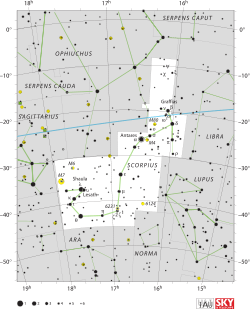Epsilon Scorpii

| |
| Observation data Epoch J2000 Equinox J2000 | |
|---|---|
| Constellation | Scorpius |
| Right ascension | 16h 50m 09.8s[1] |
| Declination | –34° 17′ 36″[1] |
| Apparent magnitude (V) | +2.310[2] |
| Characteristics | |
| Spectral type | K1 III[3] |
| U−B color index | +1.147[2] |
| B−V color index | +1.150[2] |
| Astrometry | |
| Radial velocity (Rv) | –2.5[4] km/s |
| Proper motion (μ) | RA: –614.85[1] mas/yr Dec.: –255.98[1] mas/yr |
| Parallax (π) | 51.19 ± 0.22[1] mas |
| Distance | 63.7 ± 0.3 ly (19.54 ± 0.08 pc) |
| Absolute magnitude (MV) | 0.78 ± 0.04[5] |
| Details | |
| Radius | 12.6[6] R☉ |
| Surface gravity (log g) | 2.49[7] cgs |
| Temperature | 4,560[7] K |
| Metallicity [Fe/H] | –0.17[7] dex |
| Rotational velocity (v sin i) | 2.6 ± 0.5[8] km/s |
| Other designations | |
Epsilon Scorpii (ε Sco, ε Scorpii) is a star in the southern zodiac constellation of Scorpius. Patrick Moore introduced the name Wei but this seems to be a misreading;[10] Wěi (尾), meaning the Tail, was originally the name of a Chinese asterism or Xiù comprising the stars ε, μ1−2, ζ1−2, η, θ, ι, κ, υ, and λ Scorpii.[11] This star has an apparent visual magnitude of +2.3,[2] making it the fifth-brightest member of the constellation. Parallax measurements made during the Hipparcos mission provide an estimated distance to this star of around 63.7 light-years (19.5 parsecs).[1]
Epsilon Scorpii has a stellar classification of K1 III,[3] which indicates it has exhausted the supply of hydrogen at its core and evolved into a giant star. The interferometry-measured angular diameter of this star, after correcting for limb darkening, is 5.99 ± 0.06 mas,[12] which, at its estimated distance, equates to a physical radius of nearly 13 times the radius of the Sun.[6] Presently it is generating energy through the nuclear fusion of helium at its core, which, considering the star's composition, places it along an evolutionary branch termed the red clump. The star's outer atmosphere has an effective temperature of 4,560 K,[7] giving it the orange hue of a cool K-type star. It is classified as a variable star, although it only varies by around 0.01–0.02 magnitudes.[13] Epsilon Scorpii is an X-ray source with a luminosity of (1.5–1.6) × 1027 erg s−1.[5][14]
Modern legacy
Wei appears on the flag of Brazil, symbolising the state of Ceará.[15]
See also
- Wěi Xiù (尾宿): The 6th Chinese lunar mansion.
- Mycon: fictional alien species in the computer game Star Control whose homeworld is Epsilon Scorpii
References
- 1 2 3 4 5 6 van Leeuwen, F. (November 2007), "Validation of the new Hipparcos reduction", Astronomy and Astrophysics, 474 (2): 653–664, arXiv:0708.1752
 , Bibcode:2007A&A...474..653V, doi:10.1051/0004-6361:20078357
, Bibcode:2007A&A...474..653V, doi:10.1051/0004-6361:20078357 - 1 2 3 4 Gutierrez-Moreno, Adelina; Moreno, Hugo (June 1968), "A photometric investigation of the Scorpio-Centaurus association", Astrophysical Journal Supplement, 15: 459, Bibcode:1968ApJS...15..459G, doi:10.1086/190168
- 1 2 Gray, R. O.; et al. (July 2006), "Contributions to the Nearby Stars (NStars) Project: spectroscopy of stars earlier than M0 within 40 pc-The Southern Sample", The Astronomical Journal, 132 (1): 161–170, arXiv:astro-ph/0603770
 , Bibcode:2006AJ....132..161G, doi:10.1086/504637
, Bibcode:2006AJ....132..161G, doi:10.1086/504637 - ↑ Wielen, R.; et al. (1999), Sixth Catalogue of Fundamental Stars (FK6). Part I. Basic fundamental stars with direct solutions (35), Astronomisches Rechen-Institut Heidelberg, Bibcode:1999VeARI..35....1W
- 1 2 Schroeder, K.-P.; Huensch, M.; Schmitt, J. H. M. M. (July 1988), "X-ray activity and evolutionary status of late-type giants", Astronomy and Astrophysics, 335: 591–595, Bibcode:1998A&A...335..591S
- 1 2 Lang, Kenneth R. (2006), Astrophysical formulae, Astronomy and astrophysics library, 1 (3rd ed.), Birkhäuser, ISBN 3-540-29692-1. The radius (R*) is given by:
- 1 2 3 4 McWilliam, Andrew (December 1990), "High-resolution spectroscopic survey of 671 GK giants", Astrophysical Journal Supplement Series, 74: 1075–1128, Bibcode:1990ApJS...74.1075M, doi:10.1086/191527
- ↑ Carney, Bruce W.; et al. (March 2008), "Rotation and Macroturbulence in Metal-Poor Field Red Giant and Red Horizontal Branch Stars", The Astronomical Journal, 135 (3): 892–906, arXiv:0711.4984
 , Bibcode:2008AJ....135..892C, doi:10.1088/0004-6256/135/3/892
, Bibcode:2008AJ....135..892C, doi:10.1088/0004-6256/135/3/892 - ↑ "eps Sco -- Variable Star", SIMBAD Astronomical Object Database, Centre de Données astronomiques de Strasbourg, retrieved 2012-02-23
- ↑ Moore, P. (1983), The Guinness Book of Astronomy: Facts (2nd ed.), Middlesex, UK: Guinness Superlatives Limited, p. 242
- ↑ Ridpath, Ian, Star Tales.
- ↑ Richichi, A.; Percheron, I.; Khristoforova, M. (February 2005), "CHARM2: An updated Catalog of High Angular Resolution Measurements", Astronomy and Astrophysics, 431: 773–777, Bibcode:2005A&A...431..773R, doi:10.1051/0004-6361:20042039
- ↑ Adelman, Saul J. (2001), "On the Photometric Variability of Red Clump Giants", Baltic Astronomy, 10: 593–597, Bibcode:2001BaltA..10..593A
- ↑ Gondoin, P. (December 1999), "Evolution of X-ray activity and rotation on G-K giants", Astronomy and Astrophysics, 352: 217–227, Bibcode:1999A&A...352..217G
- ↑ "Astronomy of the Brazilian Flag". FOTW Flags Of The World website.